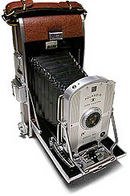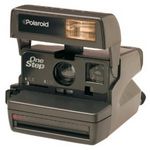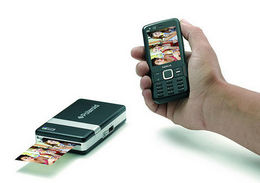Polaroid Camera
Contents
Early Years
Dr. Edwin Land (a physicist) came to the forefront of photographic technology in 1929 when he created the first synthetic sheet polarizer; thus solving "one of science’s long-standing 'unsolvable' problems – polarizing light without needing a large crystal of an esoteric mineral" (Save Polaroid). This technology enabled not only the development of the Polaroid Camera but sunglasses, 3-D glasses, glare-reducing glass and windows, and many other products as well. Then, in 1937, Dr. Land founded the Polaroid Corporation. However, the idea of an instant camera (and subsequently instant photography) wasn’t envisioned by Dr. Land until 1943 in response to his 3-year-old daughter’s confusion as to why a camera could not instantly produce pictures – “Why can’t I see them now?” (Pace).
Dr. Land was responsible for overseeing the development of products for the Polaroid Corporation – including the first instant camera. In 1947 the concept of instant photography was presented to The Optical Society in New York City and shortly after, in 1948, Polaroid 95 Instant photography became available to the public with the Polaroid Model 95 camera (also referred to as the Polaroid Land Camera) and Type 40 film. The Polaroid Land Camera was welcomed and widely accepted by consumer markets – even with a $95 price-tag (approximately $850 today) the cameras flew off shelves and sold out in a matter of weeks. The demand for the new camera was so great that backorders began being taken and consumers started to pay up to $150 (approximately $1350 today) for the new instant photography device (Save Polaroid).
A long line of instant photography developments and products proceeded the Polaroid Land Camera’s release and by the 1960’s approximately fifty-percent of American households owned a Polaroid camera (Pace).
Video - Invention: The First Polaroid Camera (Discovery Channel)
How it Works
The film used in the Polaroid Camera is unique in that it has "its own built-in developing studio" (HowStuffWorks).
"Film is a plastic base coated with particles of silver compound that are sensitive to light. Black-and-white film has one layer of silver compound, while color film has three layers -- the top layer is sensitive to blue light, the next layer is sensitive to green and the bottom layer is sensitive to red. When you expose the film, the sensitive grains at each layer react to light of that color, forming metallic silver at that layer. This gives you a chemical record of the light and color pattern.
To turn this into a picture, you have to develop the film. One developer chemical turns the exposed particles into metallic silver. The film is then treated with three different dye developers containing dye couplers. The three dye colors are cyan (a combination of green and blue light), magenta (a combination of red and blue light) and yellow (a combination of green and red light).
Each of these dye coupler types react with one of the color layers in the film. In ordinary print film, the dye couplers attach to particles that have been exposed. In color slide film, the dye couplers attach to the non-exposed areas. Developed color film has a negative image -- the colors appear opposite of the colors in the original scene. In slide film, the two dyes that attach to the unexposed area combine to form the color captured at the exposed layer. For example, if the green layer is exposed, yellow and cyan dye will attach on either side of the green layer, but the magenta dye will not attach at the green layer. The yellow and cyan combine to form green.
The instant camera developing process combines colors the same basic way as slide film. It has the same layers of light-sensitive grains as traditional film, all arranged on a plastic sheet. The film also contains several additional layers, however. These layers contain all the necessary chemicals for the development process. Underneath each color layer, there is a developer layer containing dye couplers. All these layers sit on top of a black base layer, and underneath the image layer, timing layer and acid layer. This arrangement is essentially a chemical chain reaction waiting to be set in motion.
The component that gets the developing process going is the reagent (as in re-agent), a mix of opacifiers, alkali, white pigment and other elements. The reagent sits in a layer just above the light-sensitive layers and just below the image layer. Before you take the picture, the reagent material is all collected in a blob at the border of the plastic sheet, away from the light-sensitive material. This keeps the film from developing before it has been exposed. After you snap the picture, the film sheet passes out of the camera, through a pair of rollers. The rollers spread the reagent material out into the middle of the film sheet, just like a rolling pin spreading out dough. When the reagent is spread in between the image layer and the light-sensitive layers, it reacts with the other chemical layers in the film. The opacifier material stops light from filtering onto the layers below, so the film isn't fully exposed before it is developed.
Error creating thumbnail: Unable to save thumbnail to destinationThe reagent chemicals move downward through the layers, changing the exposed particles in each layer into metallic silver. The chemicals then dissolve the developer dye so it begins to diffuse up toward the image layer. The metallic silver areas at each layer -- the grains that were exposed to light -- grab the dyes so they stop moving up. Only the dyes from the unexposed layers will move up to the image layer. For example, if the green layer was exposed, no magenta dye will make it to the image layer, but cyan and yellow will. These colors combine to create a translucent green film on the image surface. Light reflecting off the white pigment in the reagent shines through these color layers, the same way light from a bulb shines through a slide.
At the same time these reagent chemicals are working down through the light sensitive layers, other reagent chemicals are working through the upper film layers. The acid layer in the film reacts with the alkali and opacifiers in the reagent, making the opacifiers become clear. This lets you see the image below. The timing layer slows the reagent down on its path to the acid layer, to give the film time to develop before it is exposed to light.
When you watch the image in a photo film come into view, you're actually seeing this final chemical reaction. The image is already developed underneath -- you're just watching the acid layer clear up the opacifiers in the reagent so the image becomes visible" (HowStuffWorks).
Applications
-Family -Industry -...
Noteworthy Dates and Information of Several Polaroid Models
1948: The first Polaroid Land camera, a Model 95, is sold at Boston’s Jordan Marsh department store.
1964: The five-millionth Polaroid Land camera, an Automatic 100, is manufactured.
1971: The Big Shot Land Camera, designed to take flash color portraits, debuts.
1972: The SX-70 system is introduced. The camera is fully automatic, motorized, folding, single-lens reflex which ejects self developing, self-timing color prints.
1976: Sales of Polaroid cameras exceed six million units.
1977: The OneStep Land Camera is the best-selling camera in the U.S. for more than four years. This year Polaroid sales exceed $1 billion.
1986: The Spectra camera debuts at Jordan Marsh in Boston.
1998: The OneStep is the world’s best-selling camera.
1999: 9.7 million instant cameras are sold. The iZone Pocket camera and "sticker" film are introduced.
2004: Polaroid introduces a new line of six instant cameras (Naples Daily News).
Decline
Kodak Lawsuit
On October 6, 1981, in a court battle over the invention of the instant camera, the Polaroid Corporation accused the Eastman Kodak Company of "violating its patents in a way that 'strikes at the very heart of Polaroid's business'" (The New York Times). Polaroid claimed that Kodak illegally copied their technology and "entered Polaroid's exclusive field" with their 1976 introduction of an "instant color camera" (The New York Times). Polaroid's lawyer, William K. Kerr stated that "'Kodak unsuccessfully tried to develop non-infringing methods...[b]ut they bumped against stone walls and eventually were driven to infringe upon Polaroid's patents.' This patent infringement, he said, 'strikes at the very heart of Polaroid's business,' whereas instant photography represents 'only a very small part of Kodak's overall business'" (The New York Times).
In 1985 Kodak was found guilty of infringing seven of Polaroid's instant photography patents and was forced to stop producing devices that allowed for instant photography. However, the question of how much economic damage Polaroid had suffered was still unanswered (Holusha). The Polaroid Corporation claimed that Kodak's development and production of instant photography devices and products caused Polaroid to loose $4 Billion in profits. And, in a further claim that Kodak "willfully stole its technology," Polaroid asked to receive damages of $12 Billion (Holusha).
On October 12 1990, "in the largest award ever in a patent-infringement case, a Federal judge ruled...that the Eastman Kodak Company must pay the Polaroid Corporation $909.4 million for infringing Polaroid's patents for instant photography" (Holusha). Unfortunately for Polaroid, "the decision represents something of a victory for Kodak, since it is well below the $12 billion sought by Polaroid and the $1.5 to $2 billion that some financial analysts had expected" (Holusha).
Marketing
"There was a time when there was nothing to beat a Polaroid camera for instant gratification. But in a world of disposable cameras, one-hour film processing and the camcorder, Polaroid's...sales [suffered]" (Smith).
Although Polaroid began to see a drop in sales during the late-1990's some argued that it wasn't due to new progressive technology but rather due to poor marketing. Some claimed that the company was simply marketing it in the same category as "documentary" or "recording" devices when it should have been marketed as a "social enhancement device." For example, Martin Smith, BBH's deputy chairman, is cited as saying that "Polaroid operate[d] in a different market from 35mm cameras and advanced photography systems. Rather than recording the event, it add[ed] to it, and help[ed] it to become more informal. It [was] less about memories [and] more like alcohol and karaoke" (Smith).
However, even with a marketing move away from traditional camera outlets and toward buying a Polaroid Camera to enhance social occasions (such as making the cameras available at bars and clubs) sales continued to decline.
Death
It’s ironic that the death of the Polaroid (“Instant”) Camera resulted from the device’s inability to be “instant” enough. “But in a day when nearly every cellphone has a digital camera in it, ‘instant’ photography long ago stopped being instant enough for most people” (Lyons).
The Polaroid Company, which ceased their production of instant cameras for consumers a in 2007 and for commercial use in 2006, announced in 2008 that it would cease to produce and manufacture instant film in 2009.
However, the Polaroid Company is allowing their technology to be licensed to other manufacturers after 2009 – should they want to provide the film to the niche market that will continue to use the Polaroid Camera (Lyons). Furthermore, there has been confirmation that at least three of the peel-apart pack films will be reintroduced in 2009 (Zink).
Future
When the first Polaroid Camera was introduced in 1948 millions of individuals were, all of a sudden, able to quickly snap photographs and enjoy them instantly – instead of waiting several days, or longer, for them to be developed.Today, Polaroid is once again leading the way for improvements in the “instantaneity” of photography – this time with photos taken by digital cameras and camera phones.
During the third quarter of 2008 the Polaroid Corporation partnered with Zink to create and market the Polaroid PoGo Instant Mobile Printer – a small, portable, battery-powered printer from the company that was built on Edwin Land's Polaroid (Eisenberg).
“Polaroid PoGo™ - short for Polaroid-on-the-go - is a pocket-sized, ink-free digital photo printer that produces full-color photos wirelessly from Bluetooth-enabled cell phones and via PictBridge from digital cameras. Weighing only eight ounces, Polaroid PoGo™ provides consumers with a convenient solution for sharing digital images trapped on cell phones and digital cameras. Connecting via Bluetooth or PictBridge, Polaroid PoGo™ uses a revolutionary ZINK Zero Ink Zero Hassles™ Printing Technology to produce borderless, full-color, 2-inch by 3-inch prints in less than 60 seconds” (ZINK).The Polaroid PoGo printer connects to cell phones wirelessly via Bluetooth technology and to digital cameras via a cable. The Printer, when first released, cost $150 but as of October 2008 can be purchased (from some sellers) for just under $100. The images produced by the PoGo are 2 inches by 3 inches.
The PoGo is unique in that it doesn’t use cartridges or toner (because it doesn’t use ink). “Instead, there is a computer chip, a 2-inch-long thermal printhead and a novel kind of paper embedded with microscopic layers of dye crystals that can create a multitude of colors when heated” (Eisenberg).
“When the image file is beamed from the camera to the printer, a program translates pixel information into heat information. Then, as the paper passes under the printhead, the heat activates the colors within the paper and forms crisp images” (Eisenberg).
The unique paper was created by former Polaroid employees and conceptualized at Polaroid. However, after Polaroid filed bankruptcy in 2001 (and was later sold to the Petters Group) the employees founded the company ZINK Imaging in 2005 where the product was able to be developed and made available to buyers (Eisenberg).
Works Cited
Amazon. Image: Polaroid OneStep Land Camera. Amazon. 25 Oct. 2008. <http://www.amazon.com/Polaroid-One-Step-600-Instant-Camera/dp/B00004RFC5>.
Discovery Channel. Video: Invention: The First Polaroid Camera. Discovery Channel. 25 Oct. 2008 <http://videos.howstuffworks.com/discovery/29594-invention-the-first-polaroid-camera-video.htm>.
Eisenberg, Anne. Image: Edwin Land, Founder of Polaroid. The New York Times. 13 April 2008. <http://www.nytimes.com/2008/04/13/technology/13novel.html?scp=30&sq=polaroid%20camera&st=cse>.
Eisenberg, Anne. “Instant Digital Prints (and Polaroid Nostalgia).” The New York Times. 13 April, 2008. <http://www.nytimes.com/2008/04/13/technology/13novel.html?scp=30&sq=polaroid%20camera&st=cse>.
Holusha, John. “Kodak Told It Must Pay $909 Million.” The New York Times. 13 Oct.1990. <http://query.nytimes.com/gst/fullpage.html?res=9C0CE6D91F39F930A25753C1A966958260&sec=&spon=&&scp=4&sq=polaroid%20kodak%2suit&st=cse>.
Lyons, Patrick J. “Polaroid Abandons Instant Photography.” The New York Times. 8Feb. 2008. <http://thelede.blogs.nytimes.com/2008/02/08/polaroidabandons-instant-photography/?scp=2&sq=polaroid%20camera&st=cse>.
Naples Daily News. "The Polaroid Project: The Timeline." Naples Daily News. 20 April 2008. <http://www.naplesnews.com/news/2008/Apr/20/polaroid-project-timeline/>.
Pace, Eric. “Edwin H. Land Is Dead at 81; Inventor of Polaroid Camera.” The New York Times. 2 March 2 1991. <http://query.nytimes.com/gst/fullpage.html?res=9D0CE6D8133AF931A35750C0A967958260>.
Polaroid. Image: Zink Enabled Polaroid PoGo. 25 Oct. 2008. <http://www.polaroid.com/us/index.jsp?co=usbmLocale=en_US>.
Save Polaroid. “A History of Polaroid.” Save Polaroid. 23 Oct. 2008. <http://www.savepolaroid.com/history>.
Save Polaroid. Image: Edwin Land and the First Synthetic Sheet Polarizer. Save Polaroid. 23 Oct. 2008. <http://www.savepolaroid.com/history>.
Save Polaroid. Image: Polaroid Model 95 Camera. Save Polaroid. 23 Oct. 2008. <http://www.savepolaroid.com/history>.
Smith, Allison. “Having a Party with Your Polaroid Camera – Marketing Brand Management.” F.T. Business Enterprises Limited. 26 May 1998. ProQuest. NYU. 20 Oct. 2008. <http://proquest.umi.com/pqdlink?did=29683432&Fmt=7&clientId=9148&RQT=309&VName=PQD>.
The New York Times. “Polaroid Says Kodak’s Entry In to Instant Photos Injured It.” The New York Times. 6 Oct. 1981. <http://query.nytimes.com/gst/fullpage.html?res=9F03E5DF1239F935A35753C1A967948260&scp=9&sq=instant20camera%20polaroid&st=cse>.
ZINK (Zero Ink). Image: PoGo and Bluetooth Technology. ZINK. 22 Oct. 2008. <http://www.zink.com/partner-products>.
ZINK (Zero Ink). “Partner Products.” ZINK. 22 Oct. 2008. <http://www.zink.com/partner-products>.



